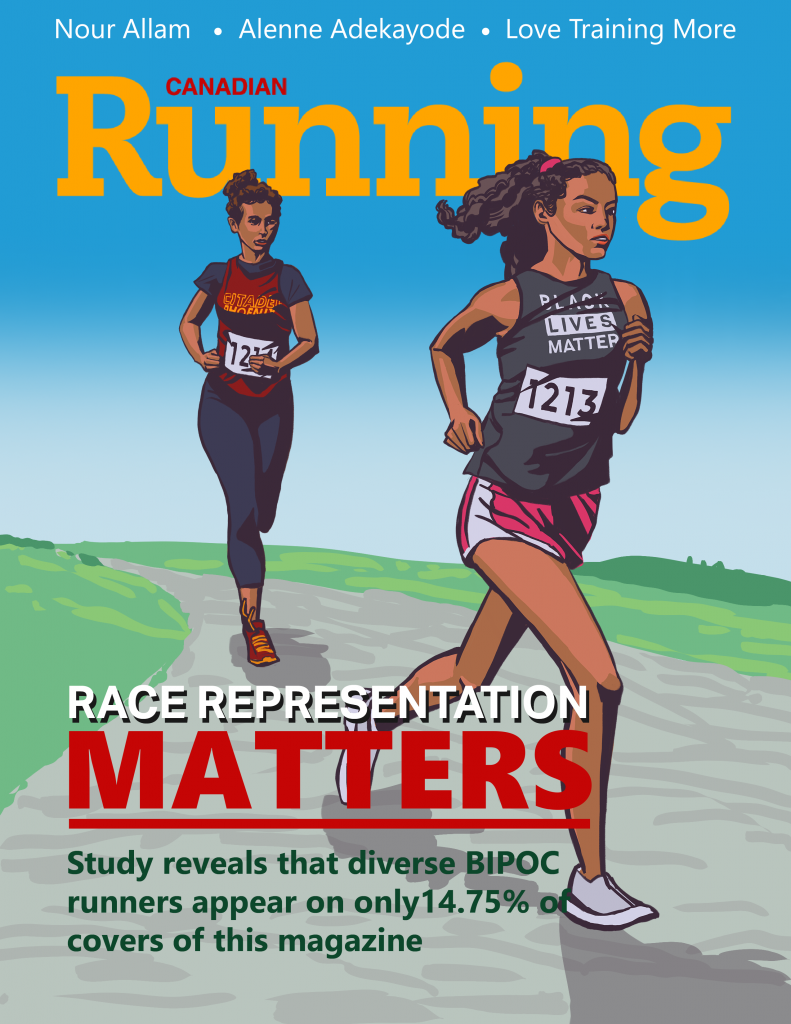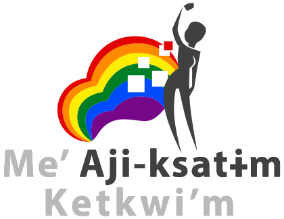
August 26, 2020
Halifax, NS
Dear Canadian Running Magazine,
My name is Erin Poirier of Halifax, NS. I am a lifelong runner. I own and am head coach of an online run coaching business, Love Training More, where we are a team of 3 women coaches. I am the head cross country and head track and field coach at one of the largest urban high schools in Nova Scotia. I have been consuming your media since your magazine’s inception. I have even been featured in the pages of your magazine (2011, my run across the nation of The Gambia). Some of my race results have been included when you cover Atlantic Canadian race roundups and when you write about the Halifax Road Hammers whom I train with.
I am writing to you today on behalf of myself and the community of Love Training More runners, regarding the race representation on your magazine covers. We applaud your last two covers featuring Mohammed Ahmed and David Joseph as well as the Sept/Oct 2020 Editorial indicating that you have a responsibility to address the under-representation of Black and Indigenous people in your pages and in the sport. We hope that this is the beginning of meaningful and sustained change. We would like to outline our displeasure with your history of under-representation on magazine covers and within the magazine and how important this issue is to us.
Your magazine was covered in The Keeping Track Podcast, June 24, 2020 episode titled, “Racing for Representation.” This episode focused on Dr. Francine Darroch (Carleton University) and Dr. Heather Hillsburg (British Columbia)’s content analysis of three popular North American running magazine cover images to assess disparities in the representation of race and gender. Issues of Runner’s World, Women’s Running, and Canadian Running published between 2009 and 2019 were examined. Analysis of your 75 issues from this ten year period revealed that Black, Indigenous and People of Colour were grossly under-represnted, appearing on the cover only 14.75% of the time (the lowest of all 3 magazines). Additionally, according to this analysis, Canadian Running featured no BIPOC athletes in 2011 and 2013, and there have been no identifiable changes over the decade.
As consumers of your media and members of the running community, we are deeply distressed and displeased with the findings of this analysis.
We know from BIPOC experts and educators that people need to see themselves represented. We all want to feel like we belong. We feel like we belong when we see others who look like us. The sport of running will grow more healthy and diverse if all people interested in running see themselves represented in the sport. It’s been a well covered part of public discourse, highlighted as clearly as ever this spring and summer with Black Lives Matter, that BIPOC people don’t see themselves in so many parts of society. This study clearly documents that BIPOC runners have not been able to see themselves in your media. Save for the last 2 issues, they are represented on the cover of your magazine only 14.75% of the time.
Most White people (especially cisgendered, heterosexual, able-bodied White people), myself included, already feel like they belong and hold privilege in nearly all spaces in our society. White people don’t need to see more of themselves on the covers of your magazine. They already know that they belong and that running is for them. They see this at every club practice they attend, every running clinic, every road race across this country. White people are there: belonging and holding privilege. In our running communities, we are missing large groups of runners who are BIPOC. We. Love Training More, are saying that their historical absence on your cover matters to us and we expect you to do your part, to do better and to fix this.
White supremacy does include extreme acts of hatred but it also means that the systems within our communities and societies continue to hold up whiteness as the standard, ideal and default for all facets of life. If you don’t meaningfully change your cover representation, then you are complicit in perpetuating white supremacy in the running community. You are contributing to whiteness being the standard, ideal and default for all things running.
Please do better.
Alternatively, you could contribute to dismantling a system of white supremacy and a system that benefits many at the expense of others.
We want to continue to see runners who are Black, Indigenous and People of Colour on the cover of your magazine and in the pages within. Over the last 10 years, you’ve displayed BIPOC bodies 14.75% of the time. How about over the next 10 years, white bodies are only displayed 14.75% of the time both on the cover and in the photos that accompany your articles. We wish to see you engage in meaningful and sustained change.
We would love to hear you comment on your history of representation. Sure, your previous issues were probably selling. Was the under-representation about your bottom line? People and racial justice are not less important than your sales and revenue.
Again, we applaud Mohammed Ahmed and David Joseph’s 2020 covers. They are a step towards 10 years of 14.75% White bodies. We are helping you out. Here are two athletes who identify as Black, Indigenous and Middle Eastern on a cover. They are Alenne Adekayode (Citadel High Class of 2020) and Nour Allam (Citadel High Class of 2021), high school athletes who I coach. They are worthy of your magazine. They have interesting and exciting young athlete lives. Nour competed in track and field meets while fasting for Ramadan. On her scholarship applications, Alenne wrote about being a role model for other BIPOC youth by running on the cross country team, showing that BIPOC youth belong there. She talked about Black Lives Matter in her valedictorian speech. These athletes matter to all of the BIPOC athletes who are coming up behind them and to the entire running community. Plus here’s a reminder that you have two full years of no BIPOC representation to make up for (2011, 2013).
Thank you for your attention to this important matter. We look forward to the BIPOC representation on the cover of your next issue as well,
Sincerely,
Erin Poirier, Head Coach, Love Training More
Crystal Pelly, Love Training More
Doreen Redmond, Love Training More
Janet Hoyt-D’Eon, Coach, Love Training More
Linda MacDonald, Coach, Love Training More
Kristina Chapman, Love Training More
Meghan Ferguson, Love Training More
Shelley Saunders, Love Training More
Sarah Waugh, Love Training More
Sacha Bremner, Love Training More
Amy D’Eon, Love Training More
Jody Wood, Love Training More
| Anne Francis <anne@runningmagazine.ca> | 12:53 PM (35 minutes ago) | ||
| to me |
Hi Erin,
Thank you for your email and for expressing your concerns. We are aware of the unpublished study you mention, and have communicated with its authors.
While the study did miss some of our covers, we do acknowledge that we must do better in making BIPOC runners more visible, both on our covers and in the pages of our magazine.
We believe we have started to make progress in this, and we plan to continue. In fact, the last three covers of our magazine featured Afro-Canadian men, starting in May with Andre De Grasse, then Moh Ahmed and now David Joseph. (The De Grasse and Ahmed covers were printed before the podcast about the study was released.)
We think we are moving in the right direction, and we expect to be held accountable if we don’t.
Best regards,
Anne
—
Anne FrancisEditor, Canadian Running Magazine



